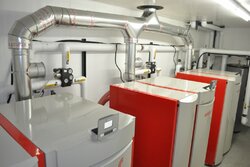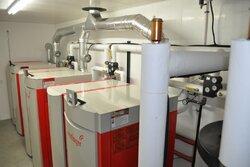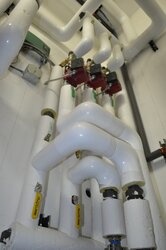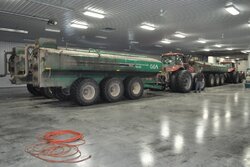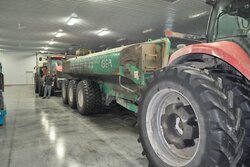Steve, are you are you using the outdoor reset for mixing or just the setpoint of the tank for boiler demand? Nice looking install, creative venting tooAre there any fan-coils for quick heat or 100% radiant?
I do a lot of multiple boiler jobs, but never with anything fun like pellets. Always oil and LP.
TS
We will be using the Tekmar just as a setpoint controller and of course staging and rotating the boilers.
Just purged the loops in the new part of the building yesterday afternoon and today so that 13,000 sq ft is up and running. Flipping the pumps on for those zones made the boilers stand up and take notice of what was going on. First time we have seen all 3 at 100% output.



The owner asked if there was some way we could install auxiliary heat that could be turned on and off independent of room temp when we were in the design phase of the project. He wanted something he could turn on when needed for deicing equipment when they take it inside.
We installed a pair of Modine vertical discharge units on the ceiling and set them up with 12 hour timers controlling them instead of thermostats. We've been heating the new area of the shop with them until today.
A couple things...........The reason for his request was graphically illustrated today when they drove in one of his 300+hp tractors with a 9,000 gallon manure tanker behind it.
There was probably 3 inches of solid, frozen poop and ice on the outside of the tank along with what was frozen to the interior walls. I asked the owner how much the total rig weighed and he said about 66,000#. Dry. So add another 5-6,000# for what was frozen on.
A little back of the napkin math indicated dragging that much steel, iron, rubber, plastic and poo from 0* up to 40ish would soak up around 1.8MMbtu
 !
!In other words, the full system output for 3 hours. I had figured some capacity into my load calc for such a purpose but neglected to ask him the weight of what he wanted thawed out. I guessed it at maybe 30,000#. ZIKES!! They bring those in one at a time and give them overnight to thaw out so we should be OK.
So this brings up the other thing I wanted to mention. Radiant heat

At the time they pulled that piece of machinery into the old shop there was only one zone calling in the wash bay and the room temps were all stable at 61* T-stat setting.
Only one boiler was running and the other two were shut off on their internal aquastats. They pulled that 35 Tons of iron and steel into the shop and within 2 minutes every zone except the office was calling for heat! Air temp only dropped to 58* but that huge amount of cold mass literally sucked heat from the floor. Within 10 minutes of the machinery getting parked inside all 3 boilers had fired and were ramped up to between 60-80% output. They were chewing on that load hard. It was stunning to realize the amount of heat flux moving from the btu's stored in the 6" slab up into that cold metal. All zones except the one under the tractor satisfied within about 30 minutes but the boiler were still pounding out around 350-400,000 btu into that slab of about 4,000 sq ft. It would seem that the entire slab was pouring heat into the big iron. Normal floor supply/return temps are 110 in and about 90-95 out but we watched as the return temp dropped into the 75* range giving us a 35*
 T.
T.Wow! just WOW!!
And here's another thing. The front part of the shop was existing radiant, the new part in back has been heated with the Modines mentioned above for the last week. We could not believe the difference in the "feel" of each area even though they were both sitting at 60*. The radiant side of the building felt warm and comfortable for working. The Modine/forced air side felt a bit chilly even though the air temp was the same. I have never had a building that I was able to observe a side by side comparison of forced air VS radiant slab in such an identical situation where air temp, building construction and all other details were the same. The difference in comfort level of the radiant side was hard to believe.
Sorry to ramble .......... a lot of cool things going on with this project.

Last edited:


 Outdoor temps were single digits to below 0 all day yesterday and Thursday when we pulled the trigger so we are pretty much at design/worst case conditions. Wind was running between 10-20mph along with it. Even the local snowy owls were holed up somewhere out of the wind.
Outdoor temps were single digits to below 0 all day yesterday and Thursday when we pulled the trigger so we are pretty much at design/worst case conditions. Wind was running between 10-20mph along with it. Even the local snowy owls were holed up somewhere out of the wind.


